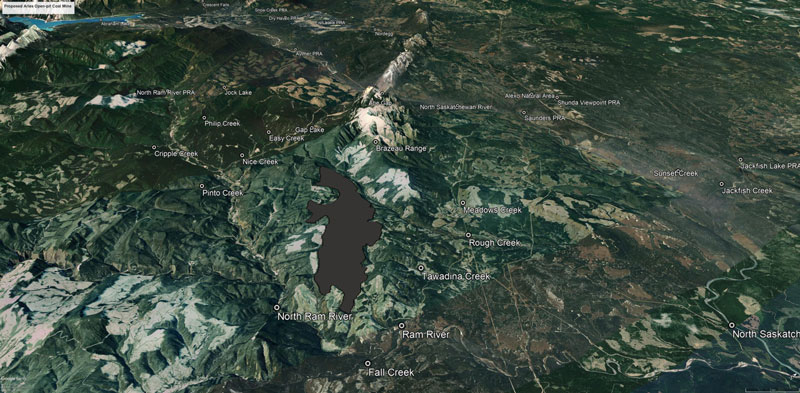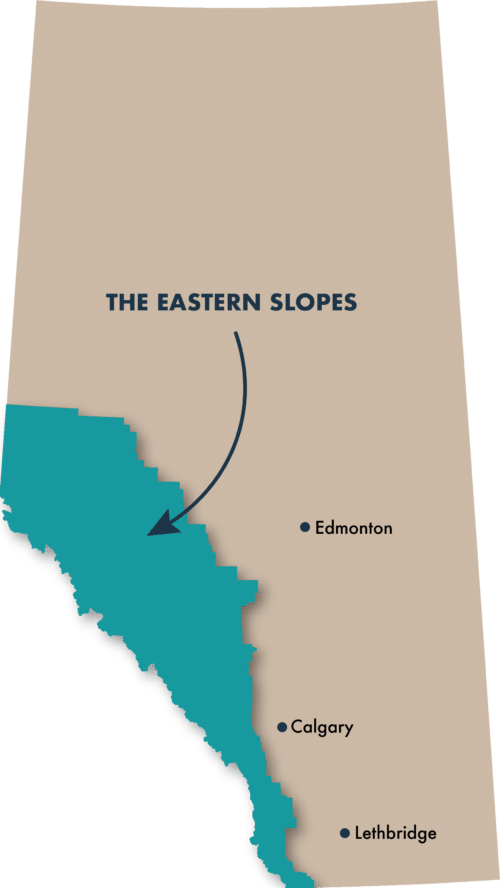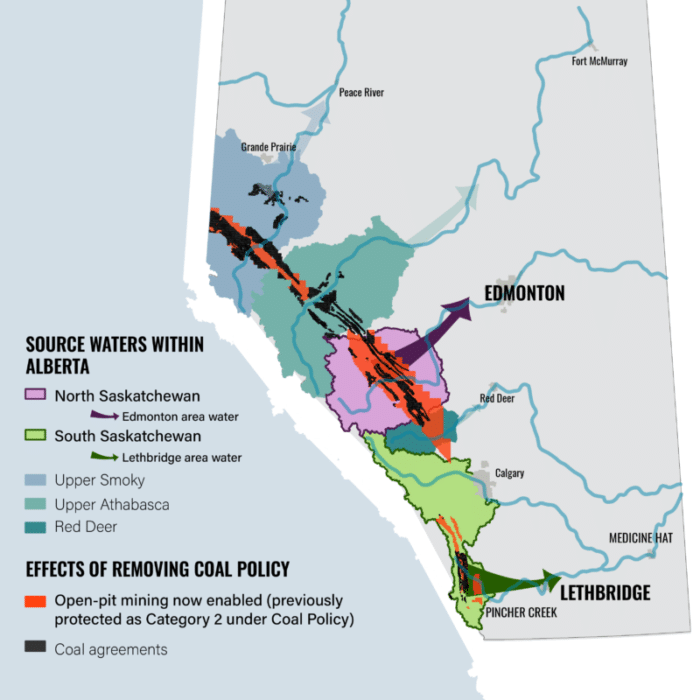Coal mining impacts Alberta's Landscapes
Alberta’s Rocky Mountains and foothills are home to world-class hiking, fishing, and camping and home to grizzly bears, native trout, and sensitive alpine species. The Bighorn Backcountry hosts some of the most beautiful and scenic views you have ever seen. Coal mining would directly conflict with recent efforts to position itself as a premier tourism destination. Of particular concern in Central Alberta are the scenic and popular areas near Nordegg, including Crescent Falls, Goldeye Lake, and Fish Lake.

Visualization of the footprint of Ram River Coal Corporation’s Aries Mine along the Ram River.
Take Action
The Biggest Coal Risk to Date: New Coal Policy Direction in Opposition to Albertans' Values
Government of Alberta MUST develop a coal policy that protects Albertans and our Future
Over the past five years, Albertans have been loud and clear that they oppose ANY new coal exploration or mining in Alberta’s Rocky Mountains and Eastern Slopes. Tens of thousands came together for a collective, concerted push against the Government of Alberta's recission of the 1976 Coal Policy and the subsequent mine exploration, which was successful in forcing the province to implement a moratorium in 2022.
Coal Mining Impacts
Loss of Habitat for At Risk Species
The Eastern Slopes provide habitat for many of Alberta’s iconic wildlife species, including species at risk such as grizzly bears, bull trout, and westslope cutthroat trout.Loss of River Habitat for Bull Trout
In Central Alberta, the Ram River and its tributaries are some of Alberta’s best habitat for bull trout and cutthroat trout. Loss of this habitat due to coal mining would be devastating to one of Alberta’s last strong populations of bull trout. These areas are also world class fly-fishing spaces.Water Contamination
Open-pit coal mining requires huge amounts of water for operations and can leach toxins like selenium into the water, and toxic tailings pose substantial risk to downstream environments. The Eastern Slopes of the Rockies are the water source for millions of Albertans, providing water to residents of Clearwater County, the Drayton Valley, the City of Edmonton, and many more, including our neighbours in Saskatchewan and Manitoba. This water also supports aquatic ecosystems and native trout. Coal mining in our headwaters puts this water source at risk.Loss of Recreational Opporunities
Coal leases, exploration and development restricts access to popular trails and viewpoints. An area that was once revered for its growing recreation and tourism economy can see those opportunities dry up once coal interests take precedence. It is not only the quantity of recreational opportunities that are impacted but quality of recreation can be impacted as dust and debris impact air quality and once celebrated viewpoints are dramatically changed.The Eastern Slopes of the Rockies are too Important to put at risk

These areas provide Albertans with our drinking water. They are home to the iconic landscapes and wildlife that bring people to our province. They support Alberta’s diverse economy by providing places for ranching and tourism to thrive. They are where Albertans go to breathe, connect with nature, and enjoy being active.
These are just some of the many reasons why we need the Eastern Slopes of the Rockies to stay protected. And we have known this information for a long time – that’s why the majority of Albertans consulted supported the 1976 Coal Policy which provided protection from open-pit coal mining to the most sensitive areas of our Rockies.
Four decades later, it has become clear that more protections from coal mining are needed in our Eastern Slopes.

Coal Mining Impacts our Communities & Headwaters
There are large areas of overlap in pre-existing coal agreements and the re-opening of open-pit mining in watersheds that flow to Edmonton, Lethbridge and their surrounding communities. The effects on water will be felt downstream by an estimated 1.4 million Albertans served by the North Saskatchewan watershed and 267,000 Albertans served by the headwaters of the Oldman River.

Maps of Coal Agreements & Coal Leases in Alberta
Coal agreements and coal leases by company in Clearwater County, with the Aries and Blackstone Projects outlined in black. According to the Valory’s investor report “Valory Resources Inc. (“Valory” or the “Company”) has entered into a binding agreement to acquire Black Eagle Mining (“Black Eagle”), … which owns 100% of the Blackstone coking coal project in Alberta, Canada.”
Old and new coal agreements surround popular tourist destinations of Crescent Falls, Goldeye Lake, and Fish Lake near Nordegg, AB.


What You Need To Know About
The Alberta Coal Policy
In June 2020, without any public consultation, the Government of Alberta cancelled a provincial Coal Policy that had been in place since 1976. Consequently, large, sensitive areas of the Rockies were opened up to the devastating impacts of coal development. This change allowed coal mining companies to buy leases across large areas of our Rockies and allowed applications for exploration and development in areas where this activity was previously prohibited.
The cancellation of the Coal Policy removed land zoning that restricted open-pit coal mining and coal exploration in some of Alberta’s most environmentally sensitive areas. These areas provide Albertans, and much of the prairies, with most of the water we use in our day-to-day lives, and are crucial habitat for species at risk such as grizzly bears, caribou, and native trout.

Rescinding the 1976 Coal Policy
The Impacts
186,187 hectares leased to mining companies
186,187 hectares of land previously unavailable for coal mining (known as ‘Category 2’ under the Coal Policy) were leased to mining companies. These leases remain in place.100s of Developed Roads & Drill Pits
Many mining companies received exploration permits for their leases and developed hundreds of kilometres of roads and hundreds of test drill pits.6 Companies Allowed to Continue After Reinstatement
Six mining projects on Category 2 lands have been exempted from the reinstatement of the Coal Policy and are still allowed to continue with these devastating exploration activities. Our team is currently awaiting confirmation of the names of these projects.Updates
Other Resources

Environment minister announces all metallurgical coal mines will undergo federal impact assessments, misses opportunity for meaningful regional assessment on Aboriginal and Treaty rights

CPAWS welcomes Canada’s firm stance on future thermal coal mining projects and project expansions

Coal Mining in Alberta: The Harms of Resource Extraction Projects to Indigenous Communities
Take Action
The Biggest Coal Risk to Date: New Coal Policy Direction in Opposition to Albertans' Values
Government of Alberta MUST develop a coal policy that protects Albertans and our Future
Over the past five years, Albertans have been loud and clear that they oppose ANY new coal exploration or mining in Alberta’s Rocky Mountains and Eastern Slopes. Tens of thousands came together for a collective, concerted push against the Government of Alberta's recission of the 1976 Coal Policy and the subsequent mine exploration, which was successful in forcing the province to implement a moratorium in 2022.
STAY INFORMED
Protect the Wilderness
To receive news and updates from CPAWS Northern Alberta, including opportunities to get involved, join our mailing list below.